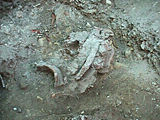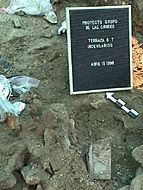
| 1997 1998 1999 2000 2001 Hilites | Page 1 - 2 - 3 |
|
In January of 1998, excavations were continued on the west side of the Temple of the Cross. Anomaly 2 is described in the GPR study as a particularly "bright region of exceptional intensity, that has a natural looking onset but an extremely abrupt, artificial looking termination. In the process of investigating Anomaly 2, the northern limits of the deteriorated stucco platform was exposed and documented.
Anomaly 3 was detected in three separate passes of the GPR unit on the west side of the terraced platform of the Temple of the Cross. This anomaly is described in the GPR report as "cavernous bedrock signatures with hyperbolic echoes". |
| As expected, the northern continuation of the deteriorated stucco terrace was encountered during excavation. Beneath the stucco surface were nine incensarios, with another nearby. |

|
| One of them appeared to face south with the front or face pitched forward at an approximate 30 degree angle. |

| Although the uppermost portions of the flanges and cylinder were fragmented, this incensario was relatively well preserved. The paste was fairly soft and damp. |
| Upon cleaning the bedrock, an unusual natural feature was discovered. The bedrock strata were tilted almost vertically and were oriented almost due east/west. |
| Even though we had almost no rain for 6 weeks, this soft stratum was very damp and is in an area where water seeps through the harder strata of bedrock and deposits silt and clay. This feature seeems to have been intentionally marked in Precolumbian times with deposits of clay and flowstones above it. |

